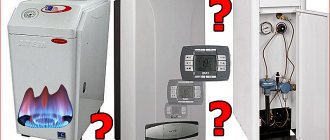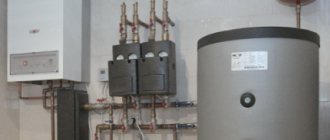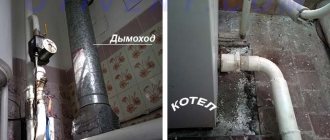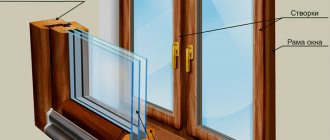The lack of a centralized heating system and a pipeline supplying natural gas forces cottage owners to look for alternative ways to economically heat their living spaces. The solution may be electric heating of a private house.
Foundation calculation
Try a new product
Try for free Find out more
Different heat sources help solve the heating problem. Their operating principle, efficiency and cost vary. To choose the best economical option, you need to weigh the advantages and disadvantages of each.
Pros and cons of electric home heating
A heating system connected to electricity requires a relatively large financial investment when purchasing and installing equipment. Monthly electricity bills also increase during the cold season. In addition, the constant switching on of heating equipment creates an increased load on the network, which can affect the operation of household appliances. Therefore, when heating a house with electric heaters, a stable voltage is necessary.
However, the existing disadvantages are offset by significant advantages. Heating a private house with electricity is beneficial because:
- The equipment has a long service life.
- Installation of most devices is not difficult.
- Operation of the system is simple and safe.
- When installing devices, it is not necessary to obtain permission.
- The operation of the equipment does not create noise in the house.

Electric heating is based on one of two principles: direct heating of the room by a device operating from the electrical network, and indirect heating, when a heating device heats radiator batteries mounted in different rooms. In the latter case, efficiency is high, since the system cools down slowly and the house remains warm for a long time. But the direct method requires lower purchase and installation costs.
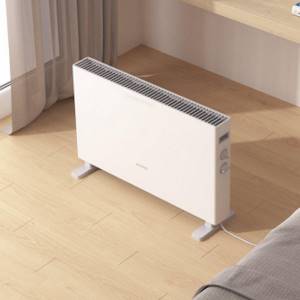
General information
Advantages and disadvantages
Just for those houses near which there are no gas mains, electric heating will be a competent and profitable solution. This alternative home heating has obvious advantages :
- + you don’t need to burn anything to get heat
- + no need to regularly replenish fuel reserves
- + no need to carry anything heavy and put it in the firebox
- + fuel itself flows through the wires
The electric heating system of a private house also has disadvantages:
- - significant energy consumption
- — constant increase in housing and communal services tariffs
- - risk of power outage without warning
- — the need to purchase an autonomous generator in case of emergency system shutdown
At the stage of designing a house, it is worthwhile, together with specialists, to develop an effective system that will make heating a country house with electricity economical, efficient and safe. Low price sometimes becomes the main factor when choosing the type of home heating. Thanks to new technologies, despite rising energy tariffs, electric heating devices are becoming more and more efficient.
Which electric heating is better?
The concept of electric heating includes a large class of technical means and methods.
Today, a home heating system can be of two types:
- With direct heat dissipation
- With intermediate coolant
The first option involves the use of heating devices such as: electric convector, spiral, infrared or quartz heater, electric fan. Such household appliances, for all their convenience and ease of operation, have a significant drawback - a very high consumption of electricity.
This does not include the underfloor heating system, which is worth talking about separately. It will really help create a comfortable temperature in your home or country house without extra costs.
The second option is a system in the “heart” of which an electric heating boiler is installed. It heats the coolant to the required temperature and distributes heat through the pipes. Any construction forum will help you find real reviews about the use of such heating systems.
If we compare a solid fuel, liquid fuel or pellet boiler against an electric one, the latter wins significantly. The main “trump card” of the latter is its high efficiency. By installing automatic thermostats on batteries, the economic effect becomes even higher. In addition, well-organized electric heating of a private home is durable, easy to use on a daily basis, and quiet. It is very attractive that the organization of electric heating does not require obtaining any permits for installation.
THIS IS IMPORTANT: You can make the use of electricity for heating cheaper by installing a two-tariff meter. So the cost per 1 kWh at night will be significantly lower.
Infrared heating
For stable heating of a private home, a system with a built-in infrared emitter is suitable. It is based on the principle of the propagation of thermal energy through infrared waves. Radiation travels through the air, and upon reaching a solid, opaque surface, it is converted into heat. Objects heated in this way themselves become a source of heat. The efficiency of such heaters is one of the highest. They allow you to save electricity and maintain the desired temperature.

There are different types of emitters. These can be classic devices in the form of plates. They have wall or ceiling mounts. The innovative form is a special infrared film, inside of which carbon emitters are hermetically sealed. Such a thin film is fixed on surfaces or used when installing heated floors.
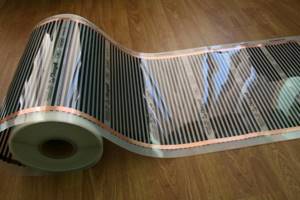
With all the advantages, infrared heaters have significant disadvantages. They heat only the space they are directed at. In other parts of the room, the air warms up less. Another weak point is the high cost. However, with a one-time investment, the costs are subsequently recouped.
Method 5 - induction boiler
An induction boiler is a transformer with two types of winding. The resulting eddy currents follow the short-circuited loop, which is the boiler body. The secondary winding receives energy, which is converted into heat, heating the coolant.
Induction boilers heat your home quickly, can operate at low voltage, and have no parts that can fail. The efficiency of such a boiler is almost 100% and does not depend on the service life.
The photo shows an induction boiler EPO Evan 9.5 kW, Russia
Convectors
An electric convector is a device consisting of a heating element, a housing and a system of regulators. The equipment operates on the principle of circulating warm air, which, according to the laws of physics, rises. Moving air currents warm the room. The surface of the case heats up slightly, so the risk of getting burned on contact is minimal.
Heating a home using such devices is considered convenient and cheap. But the use of convectors is advisable only in warm climates, where the ambient temperature does not fall below 10-15 degrees. At lower temperatures and a larger area of the house, their use requires higher financial expenses.

The advantages of such equipment include the ability to adjust the mode and temperature. Convectors are mobile, so they can be moved from room to room. Often the devices are used as an aid to the main electric heating system.
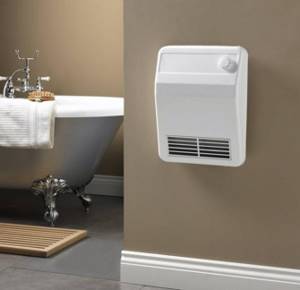
However, this method does not make it possible to heat the entire building. If the temperature is low in all rooms, several methods of heating with electricity are required. When all devices are turned on simultaneously, the load on the electrical network increases sharply and technical failures are possible.
To reduce energy costs, it is recommended to install a relay for alternating switching on of convectors.
Electricity costs
Now in terms of costs, single-tariff electric meter: 4.01 rubles per kWh. Here are all the records on energy consumption during the 20/21 heating season.
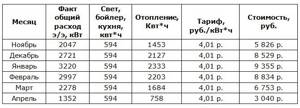
This is the second and biggest advantage compared to an electric boiler: winter 20/21 was the frostiest in recent years. The maximum electricity consumption for heating occurred in January: 2333 kWh, which is 9 thousand rubles for permanent residence. I compare it with the costs of neighbors in the village - with approximately the same houses, the cost of heating with an electric boiler was 15,000-18,000 rubles per month. Moreover, unlike us, who live permanently in a house and with a temperature of 21 degrees, neighbors sometimes visit when they are not there - the electric boiler was working at a minimum power.
The third plus in favor of the inverter system: there are no pipes and, for my taste, the design of the convector is much nicer than a boring panel radiator.
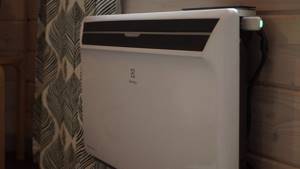
Electric boilers
There are different types of heating boilers. Their classification is based on the method of heating the coolant. Electric boilers with heating elements, induction and electrode are suitable for a private home. This equipment is characterized by high efficiency (up to 98%), compactness, environmental friendliness and ease of installation. Moreover, each type of boiler has its own characteristics.
Heating boilers
Tubular heating elements called heating elements are built into the design of the unit. An electric current passing through a conductor causes it to heat up. Next, the heat is transferred to the coolant. The operation of a heating element boiler resembles a regular electric kettle or water heater.
Despite all their efficiency, such devices are inconvenient due to possible leakage of coolant (water) and scale formation on the heating element and the walls of the boiler tank itself. The harder the water, the more plaque forms on the surface.
Operating a boiler with a heating element requires the use of special means for cleaning limescale deposits, boiled or distilled water.
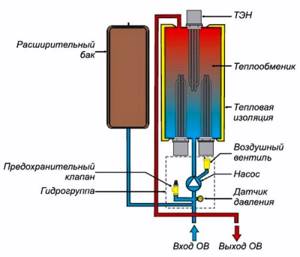
Induction boilers
The operating principle of induction equipment is to convert electromagnetic waves into thermal waves. A conductor with ferromagnetic properties is built into the device, the role of which is played by a pipeline with a circulating coolant. Induction boilers have the same disadvantages as heating element boilers. They may experience partial loss of heated water and deposition of salts on surfaces.
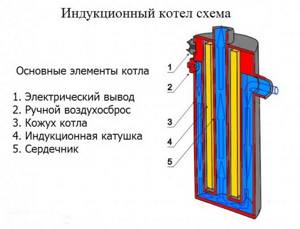
Some devices may be equipped with several heating blocks, each of which has its own housing, induction coil, inlet and outlet pipes. The boiler of any configuration is supplied with an electrical cabinet with a control unit.
Electrode boilers
These heating devices also work by heating water, but the coolant is in direct contact with electric current. The design includes electrodes that are immersed in water. Distinctive features of electrode boilers are:
- Compact dimensions of the device.
- Economical energy consumption.
- Safety during work.
- Automatic shutdown when required heating.
The efficiency criterion for electrode boilers drops noticeably if cast iron radiators are installed in the building.
Heating a house with electricity using boilers with electrodes is convenient, but it must be taken into account that the equipment does not provide a power control function. The device can only be turned on or off. Hard water promotes scale formation. Antifreeze and antifreeze cannot be used as a coolant in electrode boilers.
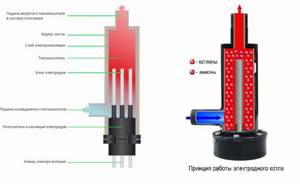
Method 2 - tubular electric heaters
They transfer heat from a tubular electric heater to a liquid-based coolant. Typically, water and oil are used as a coolant, and sometimes antifreeze. The design principle of heaters is the same as that of electric kettles, which is why they are also called heaters and oil radiators. In fact, it is a boiler placed in a vessel with water. The efficiency of such devices is quite high, and heat loss for heating is minimal.
pros
- The undoubted advantages of tubular heaters include their safety, operational reliability and versatility of use.
- Can be used in both gaseous and liquid media.
- Not explosive, and not afraid of vibrations and shocks.
- Tubular heaters are available in a variety of design solutions, which allows you to economically heat a private home with electricity without disturbing the aesthetics of the interior.
Minuses
Heating heating elements have a high cost due to the expensive metals that are used in production. Since scale forms on the pipes, it is necessary to take care of the quality of the water.
A tubular radiator is a thin-walled metal tube with a spiral inside, so if you do not need particularly high temperatures, then you need to take a heater with carbon steel tubes. If the device must produce a consistently high temperature or operate in an aggressive environment, then you need to take a device made of stainless steel.
The photo shows a tubular electric heater made by yourself
Warm floor
An electric heating system called “warm floor” is a heating element placed under the floor covering. Floor heating using electrical energy can be arranged in different ways. The following types of heated floors are distinguished:
- Cable. There are two varieties: shielded and unshielded.
- Film. The main heating element is infrared film.
- Rod. These include convection cables and carbon rods.
In a private home, all types of heated floors may be in demand. In this case, unshielded cable systems are installed in utility rooms. In living rooms, shielded cable, film or rod cables are installed. The installation method depends on which cable is used: single- or double-core. Electric cable flooring comes on sale in different forms. It could be:
- A cable that is independently distributed over the floor surface.
- A matrix in the form of a metal mesh into which the cable is mounted.
- A mat in which the heating wire is fixed to a fiberglass mesh.

Electric heat cable can be laid under different finishes, including laminate, tile, linoleum.
Despite all the convenience of heating a private home using a heated floor, this system has a significant drawback. If part of the structure is damaged, then the entire heating cable network fails. In this case, dismantling and repair are required. Only electric mats are exempt.

Since electric heating of the house through an underfloor heating element is considered expensive, it is used as an additional option. Such designs are justified in a children's room, where the child often plays on the floor. Heated floors are also in demand in the bathroom, where comfortable conditions are needed for hygiene procedures.
Oil radiators
The appearance of this type of heaters resembles conventional radiators. In parallel with the standard models, there are options on sale with a beautiful design and equipped with additional devices, for example, an ionizer or an air purifier.
The heating of the coolant is due to the heating element built into the radiator, which operates at low power (300-500 W or a little more). Mineral oil is used as a heated liquid in the devices. The battery itself, which receives and radiates heat into the air, is made of aluminum, stainless steel or steel.
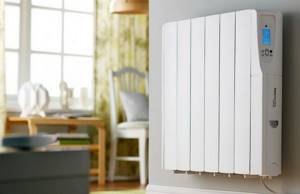
The method of heating a private house using oil radiators is more effective if used in combination with the main heating device. In addition, it is not advisable to install such heaters in children's rooms, since their body can heat up to very high temperatures. For convenience, the radiators are equipped with a mode switch
Micathermic heaters
Heating a house with electricity is also possible using micathermic batteries. This innovation came into everyday life from astronautics. The operation of the devices is based on a hybrid principle: infrared radiation plus warm air convection. Approximately 25-30% of consumed electricity goes to convection. Therefore, micathermic heaters are considered more efficient than conventional infrared counterparts.
The main structural component of the device is a mica plate, inside of which the incandescent elements are embedded. Based on their appearance, micathermic heaters are divided into cylindrical and flat. In the latter case, heat spreads only in two directions. Cylindrical appliances provide heat in all directions.

The heater body heats up no higher than 60 degrees during operation. This makes it safe and allows you to install the device in children's rooms. Electric heating using micathermic plates is considered environmentally friendly, as it does not dry out the air and maintains a comfortable microclimate in the house.
However, the perforated surface of the case contributes to the accumulation of dust, which gets into the air when heated. In addition, purchasing such an electric device for heating a home is not cheap.
The range of micathermic products is very wide. It includes mobile, floor-mounted, wall-mounted options.
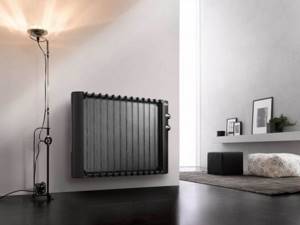
Quartz heaters
An alternative option for heating a private house with electricity can be a quartz-type device. The heating element in such devices is made using an alloy of nickel and chromium. When the device is plugged into the electrical network, the coil heats up. In parallel, infrared rays are generated and convection is initiated. Cold air is drawn in through the lower openings and heated. Blowing occurs through the upper part of the body.
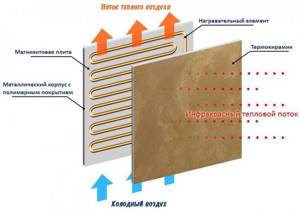
The advantages of electric heating using quartz batteries are fast heating of the surface and compact dimensions. A heater with quartz filling does not dry out the air and during its operation there is no combustion of dust particles.
Heating a private house with a quartz device is an economical, effective method. However, there are some inconveniences when using it. Firstly, the devices do not have a temperature controller. Secondly, the panels of the device are quite fragile. Thirdly, the high temperature of the case (up to 95 degrees) is dangerous due to possible burns.

Air conditioners
A popular system for heating the air in a private home is a split system with a “heating” option. Air conditioners operate on the principle of forced ventilation. At the same time, their efficiency is higher than that of convector analogues. The room warms up quickly, and the presence of automation allows you to select the desired temperature and operating mode.

The modern market presents a small range of powerful air conditioners designed to heat rooms in extreme cold. The disadvantages of using a split for electric heating of a house also include non-uniform heating of the air.
Special sensors that coordinate air flows help solve the problem of uneven heating.

Heat fans and guns
Electric heaters such as fan heaters and guns can independently heat rooms or serve as an additional source of heat to boilers and heated floors. A heat fan combines two mechanisms at the same time: a heating element and a fan. Different products differ in the quality of the heating element. When choosing, it is worth considering that some models of fan-type electrical appliances are very noisy.
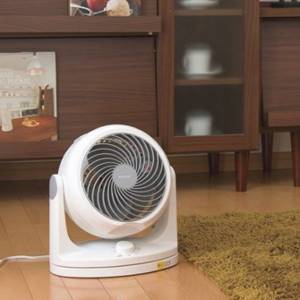
The load exerted by the fan heater is on average 1-2 kW/hour, and the heat gun operates at a power of over 4 kW/hour.
A heat gun is often used for local heating of a house, as it can warm the air in a large room. A reliable metal casing protects the device from moisture, so the device can be turned on in damp rooms that depend on electric heating.

Electric boilers: design features, advantages and disadvantages
There are three principles of heating the coolant that are used in modern hot water heating boilers:
- heating elements.
- Electrodes.
- Based on magnetic induction.
The first type of boiler is the most common. The coolant from the system enters the internal tank of the boiler unit, where it is heated by tubular heating elements, after which it enters the CO.
This type of equipment is safe, functional, and has built-in automation to control the temperature of the coolant and air in the room.
Electrode boilers use a completely different principle to heat the coolant. The heating element in them consists of a pair of electrodes to which high voltage is applied.
Electric current, passing from one electrode to another, heats the coolant, after which it enters the CO.
Important! In boiler rooms with an installation of this type, there is no electrolysis process (which eliminates the appearance of scale) since alternating voltage is used with a frequency of at least 50 Hz. Depending on the intensity of use, the electrodes become thinner over time and their ability to heat is lost. Replacing electrodes is a standard procedure in electrode boilers.
Structurally, induction boilers look more attractive, although much more complex. In this type of installation there are no (familiar to everyone) heating elements.
The coolant passes through a heat exchanger, which is part of a magnetic circuit in which a powerful magnetic field is generated. It is this that heats the heat exchanger and the coolant that circulates through the CO.
Electric heating of a country house, through indirect heat transfer, has its advantages over gas and air heating in the following: electric water heating boilers are quite reliable, have high efficiency and do not require a chimney.
As a disadvantage of such home heating, it can be noted that the use of electric boilers requires good wiring and stable voltage in the network.
Creating a water CO with an electric boiler requires significant initial costs, especially if you involve a third party to develop the project, install, configure and balance the system. You should be prepared for additional maintenance costs for such a system, which includes regular flushing of radiators, checking the operation of valves, etc.
What is the most economical way to heat a house with electricity?
If, when choosing a heating system, it was decided to go with electric heating, then it is necessary to objectively weigh all the upcoming financial costs. A competent analysis will help you avoid making a mistake in your choice. There is no single correct solution to this issue. Because different heating systems and methods are beneficial in different circumstances.
When assessing, it is important to take into account the climate, the area of the premises, the quality of insulation of the house, and the ability to use the night mode of electricity consumption. Many experts believe that the most economical heating is provided by boilers with sensors that regulate the temperature.
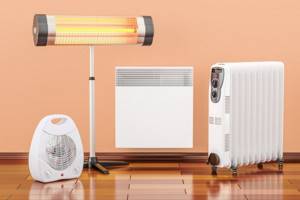
In some cases, a combination of several methods of electric heating of a private home is justified. Each device performs its specific role in the overall system. For example, if there is central heating from an electric boiler, a warm infrared floor can be installed in the child’s room and bathroom. And electric guns installed near the entrance doors can create an additional curtain of cold air. In this case, the load on the boiler is reduced and it spends less energy.
When choosing a type of electric heating, it is necessary to calculate not only the costs of purchase and installation, but also the monthly expenses for electricity for different options. A comparative analysis will highlight the most profitable methods of heating with electricity.
How to heat your home with electricity
- Water heating with electric boiler.
- Heating using electric convectors.
The first option involves creating a heating circuit that uses pipes to transport coolant, radiators to transfer thermal energy to the room, as well as the devices and mechanisms necessary for the operation of the system (expansion tank, circulation pump, shut-off and control valves, safety and control devices).
In addition, the correct scheme is necessary
The second option involves installing the required number of electric convectors in each room. The benefits are obvious: there is no need to create heating circuits, design and complex installation of equipment. All work can be done independently, without overpaying to expensive specialists.
Let's consider the design features and operating principle of each heating option, which will make it possible to conclude whether electricity can be used to heat private and country houses.


